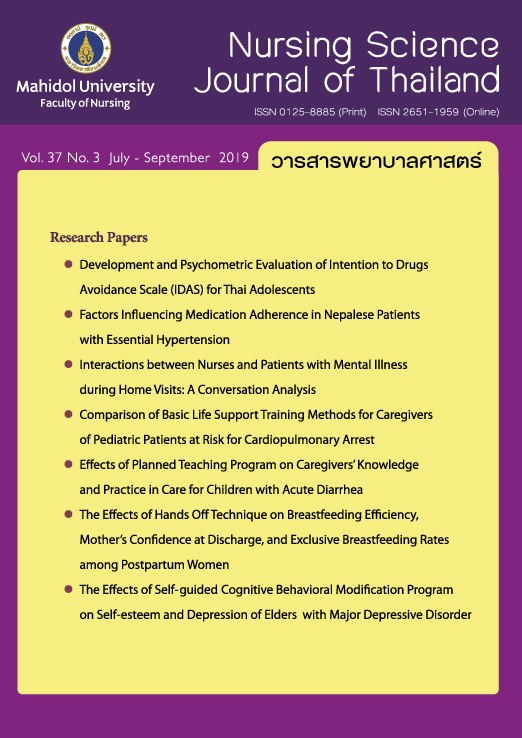ผลของโปรแกรมการสอนต่อความรู้และการปฏิบัติของผู้ดูแลในการดูแลเด็กโรคอุจจาระร่วงเฉียบพลัน
Main Article Content
บทคัดย่อ
วัตถุประสงค์: การวิจัยนี้มีวัตถุประสงค์เพื่อศึกษาผลของโปรแกรมการสอนต่อความรู้และการปฏิบัติของผู้ดูแลในการดูแลเด็กโรคอุจจาระร่วงเฉียบพลัน
รูปแบบการวิจัย: การวิจัยกึ่งทดลอง
วิธีดำเนินการวิจัย: กลุ่มตัวอย่าง คือ ผู้ดูแลเด็กโรคอุจจาระร่วงเฉียบพลันอายุ 2-10 ปี ที่พาเด็กมารับการตรวจรักษาแผนกผู้ป่วยนอกกุมารเวชกรรมในโรงพยาบาลเอกชน 2 แห่ง ระหว่างเดือนมิถุนายนถึงเดือนพฤศจิกายน 2560 จำนวน 30 คน แบ่งเป็นกลุ่มละ 15 คน กลุ่มทดลองเข้าร่วมโปรแกรมการสอนซึ่งประกอบด้วยกิจกรรมตามแผนการสอน ซึ่งได้แก่ การให้ความรู้ผ่านสื่อคอมพิวเตอร์ การสาธิตและการสาธิตย้อนกลับ การอภิปรายซักถาม การให้คำแนะนำ และเสริมแรงด้วยการชมเชยให้กำลังใจ ส่วนกลุ่มควบคุมได้รับการสอนตามปกติ เครื่องมือวิจัยสำหรับเก็บข้อมูลประกอบด้วยแบบประเมินความรู้ และแบบประเมินการปฏิบัติของผู้ดูแลเด็กโรคอุจจาระร่วง วิเคราะห์ข้อมูลด้วยสถิติพรรณนา การทดสอบที แบบสองกลุ่มอิสระและแบบกลุ่มเดียว
ผลการวิจัย: พบว่าผู้ดูแลกลุ่มทดลองมีคะแนนเฉลี่ยความรู้หลังได้รับโปรแกรมสูงกว่าก่อนได้รับโปรแกรม อย่างมีนัยสำคัญทางสถิติ (t = -12.118, p < .05) และเมื่อเปรียบเทียบกับกลุ่มที่ได้รับการดูแลตามปกติ พบว่า ภายหลังสิ้นสุดโปรแกรมผู้ดูแลกลุ่มทดลองมีคะแนนเฉลี่ยความรู้ในการดูแลเด็กโรคอุจจาระร่วงเฉียบพลันสูงกว่าอย่างมีนัยสำคัญทางสถิติ (t = - 5.478, p < .05) โปรแกรมการสอนมีผลให้ผู้ดูแลร้อยละ 80 (จำนวน 12 คนจาก 15 คน) สามารถดูแลเด็กโรคอุจจาระร่วงถูกต้องโดยได้คะแนนปฏิบัติมากกว่าร้อยละ 80
สรุปและข้อเสนอแนะ: โปรแกรมการสอนในการดูแลเด็กโรคอุจจาระร่วงช่วยให้ผู้ดูแลเด็กมีความรู้มากขึ้นและปฏิบัติการดูแลได้ถูกต้อง ผลการศึกษาแสดงให้เห็นถึงประโยชน์ของการนำสื่อคอมพิวเตอร์ร่วมกับการสาธิตและสาธิตย้อนกลับ มาใช้ในการสอนให้ความรู้แก่ผู้ดูแล
Article Details
ลิขสิทธิ์: วารสารพยาบาลศาสตร์เป็นเจ้าของลิขสิทธิ์ในการเผยแพร่ผลงานที่ตีพิมพ์ ห้ามผู้ใดนำบทความที่ได้รับการตีพิมพ์ในวารสารพยาบาลศาสตร์ไปเผยแพร่ในลักษณะต่างๆ ดังต่อไปนี้ การส่งบทความไปตีพิมพ์เผยแพร่ที่อื่น การนำบทความเผยแพร่ออนไลน์ การถ่ายเอกสารบทความเพื่อกิจกรรมที่ไม่ใช่การเรียนการสอน ยกเว้นเสียแต่ได้รับอนุญาตจากวารสารพยาบาลศาสตร์

Disclaimer: เนื้อหาบทความหรือข้อคิดเห็นใดๆ ในวารสารพยาบาลศาสตร์ ถือเป็นความรับผิดชอบของผู้เขียน กองบรรณาธิการไม่จำเป็นต้องเห็นด้วยและไม่มีส่วนรับผิดชอบแต่อย่างใด
เอกสารอ้างอิง
2. Bureau of Epidemiology, Department of Disease Control, Ministry of Public Health. Reported case of acute diarrhea in Thailand 2014 [Internet]. Nonthaburi: Ministry of Public Health; 2015 [cited 2015 Aug 24]. Available from: http://www.boe.moph.go.th/files/report/20141118_73833751.pdf. (in Thai).
3. Bureau of Epidemiology, Department of Disease Control, Ministry of Public Health. Disease situation that required epidemiological surveillance in Lower Southern Thailand, May 2019 (data as of May 31, 2019) [Internet]. Nonthaburi: Department of Disease Control, Ministry of Public Health; 2019 [cited 2019 Aug 1]. Available from: https://ddc.moph.go.th/uploads/files/50df825f499753547a127558a84f9f3f.pdf. (in Thai).
4. Theerawitthayalert R, Chongthawonsatid S, Narasetaphan P. Knowledge and behavior of care-taker on prevention of diarrhoeal disease in children. Disease Control Journal. 2009;35(1):39-46. (in Thai).
5. Pantenburg B, Ochoa TJ, Ecker L, Ruiz J. Feeding of young children during diarrhea: caregivers’ intended practices and perceptions. Am J Trop Med Hyg. 2014;91(3):555-62.
6. Álvarez Aldeán J, Aristegui J, Lopez-Belmonte JL, Pedros M, Sicilia JG. Economic and psychosocial impact of rotavirus infection in Spain: a literature review. Vaccine. 2014;32(30):3740-51.
7. Dennehy PH. Acute diarrheal disease in children: epidemiology, prevention, and treatment. Infect Dis Clin North Am. 2005;19(3):585-602.
8. Brisson M, Senecal M, Drolet M, Mansi JA. Health-related quality of life lost to rotavirus-associated gastroenteritis in children and their parents: a Canadian prospective study. Pediatr Infect Dis J. 2010;29(1):73-5.
9. Wilson ME, Megel ME, Enenbach L, Carlson KL. The voices of children: stories about hospitalization. J Pediatr Health Care. 2010;24(2):95-102.
10. Burke RM, Rebolledo PA, Embrey SR, Wagner LD, Cowden CL, Kelly FM, et al. The burden of pediatric diarrhea: a cross-sectional study of incurred costs and perceptions of cost among Bolivian families. BMC Public Health. 2013;13:708. doi: 10.1186/1471-2458-13-708.
11. Lee WS, Chai PF, Ismail Z. Impact on parents during hospitalization for acute diarrhoea in young children. Singapore Med J. 2012;53(11):755-9.
12. Varavithya W, Wajaradul C, Aanpreung P, Phuapradit P, Poovorawan Y, Vivatvakin B, et al. Clinical practice guideline for treatment of acute diarrhea [Internet]. Bangkok: The Royal College of Pediatricians of Thailand & Pediatric Society of Thailand; 2016 [cited 2019 Aug 1]. Available from: http://www.thaipediatrics.org/Media/media-20161222110358.pdf. (in Thai).
13. Nir V, Nadir E, Schechter Y, Kline-Kremer A. Parents’ attitude toward oral rehydration therapy in children with mild-to-moderate dehydration. ScientificWorldJournal. 2013;828157. doi: 10.1155/2013/828157.
14. Anidi I, Bazargan M, James FW. Knowledge and management of diarrhea among underserved minority parents/caregivers. Ambul Pediatr. 2002;2(3):201-6.
15. Bachrach LR, Gardner JM. Caregiver knowledge, attitudes, and practices regarding childhood diarrhea and dehydration in Kingston, Jamaica. Rev Panam Salud Publica. 2002;12(1):37-44.
16. Nookong A, Payakkaraung S, Pongsaranuntakul Y, Chudapongse S. Caregivers’ management for children with asthma. Journal of Nursing Science. 2012;30(1):49-60. (in Thai).
17. Sillah F, Ho HJ, Chao JC. The use of oral rehydration salt in managing children under 5 y old with diarrhea in the Gambia: knowledge, attitude, and practice. Nutrition. 2013;29(11-12):1368–73.
18. Yingrengreung S. The effectiveness of health education program with group process on maternal health behaviors in primary care of diarrheal disease in children under two years at Queen Sirikit National Institute of child health [master’s thesis]. Bangkok: Srinakharinwirot University; 1998. 129 p. (in Thai).
19. Ma-on O. Effects of potential development program on caregiver’s caring behavior for acute diarrhea in children [master’s thesis]. Khon Kaen: Khon Kaen University; 2009. 149 p. (in Thai).
20. World Health Organization. Integrated management of childhood illness: distance learning course [Internet]. Geneva, Switzerland: WHO; 2014 [cited 2016 Dec 9]. Available from: http://www.who.int/iris/bitstream/10665/104772/6/9789241506823_Module-4_eng.pdf
21. Songkram N. Multimedia for learning: design and development. Bangkok: Chulalongkorn University Printing House; 2010. 163 p. (in Thai).
22. Khotrakul S. Education psychology. Bangkok: Chulalongkorn University Printing House; 2009. 524 p. (in Thai).
23. Suknithi J, Thampanichawat W, Wichiencharoen K, Lerthamatewe W. Impact of oral stimulation program on nursing mothers’ knowledge of oral stimulation and prematurely born infants’ suckling ability. Thai Journal of Nursing Council. 2012;27(1):78-91. (in Thai).
24. Anderson LW, Krathwohl DR, Airasian PW, Cruikshank KA, Mayer RE, Pintrich PR, et al. A taxonomy for learning, teaching and assessing: a revision of Bloom’s taxonomy of education objectives. New York: Addison Wesley Longman; 2001. 302 p.
25. Manussthit S. Acute diarrhea. In: Pongprasopchai S, Thanwandi T, Manussthit S, editors. Clinical practice in gastroenterology. Bangkok: Bangkok Wetchasan Printing House; 2012. p.108-19. (in Thai).
26. Freedman SB, Couto M, Spooner L, Haladyn JK. The implementation of a gastroenteritis education program. Am J Emerg Med. 2011;29(3):271-7.


